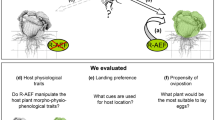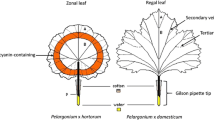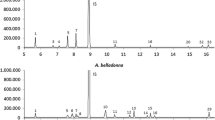Abstract
The melon thrips, Thrips palmi Karny (Thysanoptera: Thripidae), is a serious agricultural pest of many crops. Previous studies have shown that red light decreases the number of Thrips palmi in greenhouses. In order to understand how red light affects T. palmi, we examined the behavioral responses to host plants that were irradiated with a red light-emitting diode panel (660 nm) in an environment with natural or fluorescent (normal-white) light. When T. palmi were allowed to move freely around in the experimental arena, we found that fewer individuals were attracted to plants irradiated by red light than to plants under normal light illumination. We then used a sticky trap of green coloration to exclude olfactory and visual stimuli associated with the host plants in order to test binary choice behavior in T. palmi. The number of thrips attracted to the green sticky trap irradiated with red light was approximately half of that without red light irradiation. This is the first study to show that an addition of red light can change the behavior of insects, leading to an avoidance of green targets in an environment of normal illumination.







Similar content being viewed by others
Change history
05 April 2018
Unfortunately, the Table 1 was published incorrectly in the original publication of the article. The correct version of Table 1 is as below.
References
Bao WX, Sonoda S (2012) Resistance to cypermethrin in melon melon thrips, Thrips palmi (Thsanoptera: Thirpidae), is conferred by reduced sensitivity of the sodium channel and CYP450-mediated detoxification. Appl Entomol Zool 47:443–448. https://doi.org/10.1007/s13355-012-0141-7
Bernard GD (1979) Red-absorbing visual pigment of butterflies. Science 203:1125–1127. https://doi.org/10.1126/science.203.4385.1125
Briscoe A, Chittka L (2001) The evolution of colour vision in insects. Annu Rev Entomol 46:471–510. https://doi.org/10.1146/annurev.ento.46.1.471
Hori M, Suzuki A (2017) Lethal effect of blue light on strawberry leaf beetle, Galerucella grisescens (Coleoptera: Chrysomelidae). Sci Rep 7:2694. https://doi.org/10.1038/s41598-017-03017-z
Hori M, Shibuya K, Sato M, Saito Y (2014) Lethal effects of short-wavelength visible light on insects. Sci Rep 4:7383. https://doi.org/10.1038/srep07383
Katai Y, Ishikawa R, Doi M, Masui S (2015) Efficacy of red LED irradiation for controlling Thrips palmi in greehouses melon cultivation. Jpn J Appl Entomol Zool 59:1–6. https://doi.org/10.1303/jjaez.2015.1 (in Japanese with English summary)
Kawai A (1986) Studies on population ecology of Thrips palmi Karny. X. Differences in population growth on various crops. Jpn J Appl Entomol Zool 30:7–11. https://doi.org/10.1303/jjaez.30.7 (in Japanese with English summary)
Kawai A (1990) Control of Thrips palmi Karny in Japan. Jpn Agric Res Q 24:43–48
Kelber A (1999) Ovipositing butterflies use a red receptor to see green. J Exp Biol 202:2619–2630
Lindström M, Meyer-Rochow VB (1987) Near infrared sensitivity of the eye of the crustacean Mysis relicta. Biochem Biophys Res Comm 147:747–752
MacLeod A, Head J, Gaunt A (2004) An assessment of the potential economic impact of Thrips palmi on horticulture in England and the significance of a successful eradication campaign. Crop Prot 23:601–610. https://doi.org/10.1016/j.cropro.2003.11.010
Martínez-Harms J, Vorobyev M, Schorn J, Shmida A, Keasar T, Homberg U, Schmelin F, Menzel R (2012) Evidence of red sensitive photoreceptors in Pygopleurus israelitus (Glaphyridae: Coleoptera) and its implications for beetle pollination in the southeast Mediterranean. J Comp Physiol A 198:451–463. https://doi.org/10.1007/s00359-012-0722-5
Matsumoto K (2010) Present and future of the spectroscopic imaging. Comp Physiol Biochem 27:19–27. https://doi.org/10.3330/hikakuseiriseika.27.19 (in Japanese)
Morishita M (1993) Toxicity and synergism of some insecticides against larvae of Thrips palmi Karny (Thysanoptera: Thripidae). Jpn J Appl Entomol Zool 37:153–157. https://doi.org/10.1303/jjaez.37.153 (in Japanese with English summary)
Morse JG, Hoddle MS (2006) Invasion biology of thrips. Annu Rev Entomol 51:67–89. https://doi.org/10.1146/annurev.ento.51.110104.151044
Mound LA (1997) Biological diversity. In: Leiws T (ed) Thrips as crop pests. CAB Int, Oxford, pp 197–215
Mumford RA, Barker I, Wood KR (1996) The biology of the tospoviruses. Ann Appl Biol 128:159–183. https://doi.org/10.1111/j.1744-7348.1996.tb07097.x
Murai T (2002) Thrips and Tospoviruses: The pest and vector from the East: Thrips palmi. In: Proceedings of the 7th international symposium on Thysanoptera, 2–7 of July 2001, Reggio Calabria, IT, Australian National Insect Collection, Canberra, pp 19–32
Murata M, Hariyama T, Yamahama Y, Toyama M, Ohta I (2017a) Effects of the range of light wavelengths on the phototactic behaviour and biological traits in the melon thrips, Thrips palmi Karny (Thysanoptera: Thripidae). Ethol Ecol Evol. https://doi.org/10.1080/03949370.2017.1320688
Murata M, Hariyama T, Yamahama Y, Toyama M, Ohta I (2017b) Red light deters female adults of the melon thrips, Frankliniella occidentalis from the tomato plant. Ann Rept Kansai Pl Prot 59:93–95. https://doi.org/10.4165/kapps.59.93 (in Japanese with English summary)
Saurav GK, Daimei G, Rana VS, Popli S, Rajagopal R (2016) Detection and localization of Wolbachia in Thrips palmi Karny (Tyrsanoptera: Thripidae). Indian J Microbiol 56:167–171. https://doi.org/10.1007/s12088-016-0567-7
Schoonhoven LM, Jermy T, van Loon JJA (1998) Host–plant selection: how to find a host plant. In: Schoonhoven LM, Jermy T, van Loon JJA (eds) Insect–plant biology. Chapman & Hall, London, pp 121–153
Shibao M, Tanaka H (2015) The effects of eggplants illuminated by red LED (light emitting diode) on the population density of the melon thrips, Thrips palmi (Thysanoptera: Thripidae). Jpn J Appl Entomol Zool 59:7–9. https://doi.org/10.1303/jjaez.2015.7 (in Japanese with English summary)
Takeuchi S, Takeda K, Shiramatsu T, Horiuchi M (1983) Daily activity of Thrips palmi Karny. Proc Kanto-tosan Pl Protec Soc 30:144–145. https://doi.org/10.11337/ktpps1954.1983.144 (in Japanese)
Terry LI (1997) Host selection, communication and reproductive behaviour. In: Lewi T (ed) Thrips as crop pests. CAB Int, Oxford, pp 65–118
Wakakuwa M, Stewart F, Matsumoto Y, Matsunaga S, Arikawa K (2014) Physiological basis of phototaxis to near-infrared light in Nephotettix cincticeps. J Comp Physiol A 200:527–536. https://doi.org/10.1007/s00359-014-0892-4
Yang EC, Osorio D (1991) Spectral sensitivities of photoreceptors and lamina monopolar cells in the dragonfly, Hemicordulia tau. J Comp Physiol A 169:663–669. https://doi.org/10.1007/BF00194895
Acknowledgements
We express our sincere thanks to Eiji Yano (Kindai University, Japan), Ryusuke Ishikawa and Makoto Doi (Shizuoka Prefecture Research Institute of Agriculture and Forestry, Japan), and Manabu Shibao and Kanako Shirotsuka (Research Institute of Environment, Agriculture and Fisheries, Osaka Prefecture, Japan) for their technical advice. We wish to express our thanks to Victor Benno Meyer-Rochow for helpful linguistic suggestions and scientific comments on the manuscript. We thank Takayuki Mitsunaga (Central Region Agricultural Research Center, NARO) and Katsuyuki Kohno (NIVFS) for their advice about statistical analyses, and Tamotsu Murai (Ustunomiya University, Japan) for providing the T. palmi population. We also thank Hisayoshi Maruyama and Mitsuko Okamoto (NIVFS) for their technical assistance during this study. We are very grateful to anonymous reviewers for helpful and constructive comments. This work was supported by the Cabinet Office, Government of Japan, Cross-ministerial Strategic Innovation Promotion Program (SIP), “Technologies for creating next-generation agriculture, forestry and fishers” (funding agency: Bio-oriented Technology Research Advancement Institution, NARO).
Author information
Authors and Affiliations
Corresponding author
Electronic supplementary material
Below is the link to the electronic supplementary material.
13355_2017_537_MOESM2_ESM.pdf
Fig. S2: Illustration of the setup used in Experiment 4. A light reflector board (a white acrylic board measuring 100 cm long, 65 cm wide, and 5 mm thick) was set at a 45-degree angle relative to the floor of a black box (42 cm long, 30 cm wide, 15 cm high). A xenon lamp was placed horizontally relative to the ceiling of the black box and light irradiated toward the acrylic pipe via the reflector board. A black board (110 cm long and 65 cm wide) was set between the black box and the xenon lamp so that light was focused towards the reflector board (PDF 147 kb)
Rights and permissions
About this article
Cite this article
Murata, M., Hariyama, T., Yamahama, Y. et al. In the presence of red light, cucumber and possibly other host plants lose their attractability to the melon thrips Thrips palmi (Thysanoptera: Thripidae). Appl Entomol Zool 53, 117–128 (2018). https://doi.org/10.1007/s13355-017-0537-5
Received:
Accepted:
Published:
Issue Date:
DOI: https://doi.org/10.1007/s13355-017-0537-5




